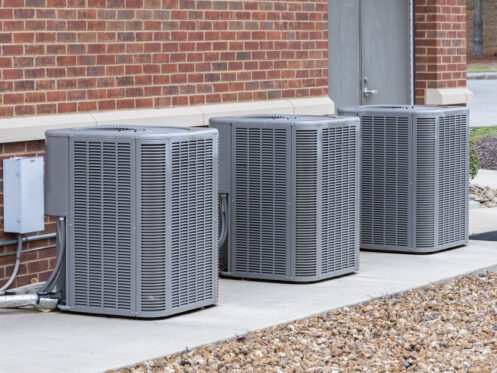The best way to make sure your AC is ready to keep you cool and comfortable is to schedule professional maintenance during the spring. A professional will perform a variety of tasks to improve the AC’s performance and energy use. In doing so, you’ll notice a more comfortable interior atmosphere along with lower cooling bills.
1. Replace Dirty Air Filters
Replacing dirty air filters is a crucial aspect of spring maintenance for an AC system because it ensures optimal performance and efficiency. Dirty filters restrict airflow, forcing the system to work harder to cool your home. Over time, this increased energy consumption leads to higher utility bills. Clogged filters can also cause the evaporator coils to freeze, resulting in reduced cooling capacity and potential damage to the compressor. If you don’t replace a clogged filter, you greatly increase the risk of the AC breaking down when you need it most.
2. Check the Outdoor Unit
To inspect an outdoor AC unit, start by visually inspecting the unit for any signs of damage, such as dents or debris buildup. Ensure that the area around the unit is clear of obstructions and vegetation to promote proper airflow. Check the fins and coils for dirt or debris. Gently clean them with a soft brush or vacuum if they are dirty. If you schedule professional maintenance, an expert will clean the outdoor unit for you.
3. Clear the Condensate Drain Line
A professional can also help with clearing the condensate drain line. A condensate drain line on an AC system removes excess moisture produced during the cooling process. As time passes, algae, mold and debris can accumulate in the drain line, causing clogs. To clean the drain line, an expert will first locate the drain line access point, typically near the indoor unit. They may use a wet/dry vacuum or a special brush to remove debris and buildup from the line. Alternatively, they may flush the line with a solution of water and vinegar to dissolve any organic matter and prevent future clogs.
4. Clean Dirty Evaporator Coils
Experts can help with cleaning dirty evaporator coils as well. Evaporator coils on an AC system play a crucial role in the cooling process by absorbing heat from indoor air. When dirt, dust and debris build up on the coils, they inhibit heat transfer and reduce the AC’s efficiency. This buildup can even cause the coils to freeze or become less effective at cooling. To clean the coils, an expert will first access the indoor unit and carefully remove any access panels. They may then use a soft brush, compressed air or a commercial coil cleaner to gently remove dirt and debris. This restores optimal heat transfer and system performance.
5. Seal Leaky Ductwork
Leaky ductwork can significantly impact the performance of an air conditioner by leading to air loss, causing uneven cooling throughout the home. Leaky ducts also make it easier for dust, debris and other pollutants to enter the AC, compromising indoor air quality. To seal leaky ductwork, experts typically use mastic sealant or metallic tape to cover the gaps and joints in the ducts. They may also use a duct sealant aerosol or injectable sealant to reach inaccessible areas.
6. Test Thermostat Accuracy
To test a thermostat’s accuracy, place a thermometer nearby and compare the readings. If the temperatures on both devices don’t match, it may need calibration. Remove the cover and locate the calibration dial or switch. Adjust it until the thermostat matches the thermometer. This ensures precise temperature control. Accurate thermostat settings prevent the AC from overworking or underperforming. Calibration also ensures consistent cooling throughout the home, avoiding unnecessary energy consumption.
7. Trim Vegetation Around Outdoor Unit for Airflow
Overgrown vegetation can obstruct airflow, reducing the AC’s efficiency and causing it to work harder to cool the air. By clearing the area around the unit, air can freely circulate, allowing the system to operate more efficiently and effectively. Improved airflow also helps prevent overheating and compressor failure. Keeping vegetation trimmed reduces the risk of debris entering the unit as well. This minimizes potential damage and prolongs the lifespan of the AC.
8. Check Insulation on Refrigerant Lines
To check insulation on refrigerant lines, visually inspect the lines for any signs of wear, damage or missing insulation. Pay attention to any areas that have worn-out insulation, exposing the refrigerant lines. Check for signs of moisture or condensation, which can indicate insulation issues. If you notice any damage or deterioration, it’s best to call an expert for inspection and repair. They can assess the extent of the damage and replace the insulation if necessary.
9. Wipe Down Air Vents
Dust, dirt and debris accumulation on air vents obstructs airflow and reduces the AC’s efficiency. Cleaning the vents removes these contaminants, allowing air to flow freely and evenly throughout the home. This not only improves the system’s performance but also enhances indoor air quality by reducing the circulation of allergens and pollutants.
10. Clean Ceiling Fans and Reverse Direction for Cooling
Ceiling fans have a substantial impact on the performance of air conditioners. Keeping them clean is essential to boosting their effectiveness. By cleaning the blades, you can improve airflow and prevent the circulation of dust and allergens in the home. Reversing the direction of ceiling fans to counterclockwise helps create a cooling breeze during warmer months. This reduces your reliance on air conditioning and saves on energy costs.
11. Inspect and Clean Attic and Crawl Space Ventilation
Just like most other parts of your home, dust and other pollution can easily settle in the attic and crawl spaces. If you don’t clean these areas, the buildup of contaminants can hinder ventilation. By taking time to carefully clean these areas each spring, you’ll improve ventilation, making it much easier for the AC to cool your home. Regularly cleaning bathroom and kitchen exhaust fans will enhance ventilation even more.
12. Inspect Insulation and Seals on Windows and Doors
When checking the insulation and door and window seals, make sure there are no visible cracks, holes or wear and tear on the seals. To prevent air leaks, you must replace broken weatherstripping or caulking. You should also look for cracks or holes in the wall or window frames that might let hot air in and cold air out. Well-insulated doors and windows help keep the inside at a constant temperature, which is easier on the air conditioner and results in better efficiency.
13. Test AC Settings and Safety Control Features
Test the system’s safety controls, such as the high-pressure and low-pressure switches, to verify they function correctly. Check the emergency shutoff switch and inspect the circuit breakers for any signs of damage. Testing these features ensures the AC operates safely and efficiently, preventing potential malfunctions or breakdowns.
It gets blistering hot in Glendale, AZ, during the summer. To that end, it is crucial to plan air conditioning maintenance throughout the spring, and Christian Brothers Air Conditioning Plumbing Electrical is here to help. We work on ACs, heaters and ductless systems. We also offer duct repair, indoor air quality testing, insulation services and more.
Contact us today to ensure your AC is ready to keep you cool this summer.










